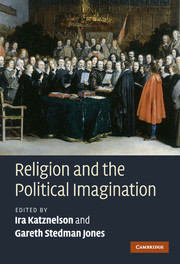Book contents
- Frontmatter
- Contents
- List of contributors
- Acknowledgements
- Introduction: multiple secularities
- 1 Secularisation: religion and the roots of innovation in the political sphere
- 2 Regarding toleration and liberalism: considerations from the Anglo-Jewish experience
- 3 The Enlightenment, the late eighteenth-century revolutions and their aftermath: the ‘secularising’ implications of Protestantism?
- 4 In the lands of the Ottomans: religion and politics
- 5 The Russian Orthodox Church and secularisation
- 6 The American experience of secularisation
- 7 French Catholic political thought from the deconfessionalisation of the state to the recognition of religious freedom
- 8 Religion and the origins of socialism
- 9 From 1848 to Christian Democracy
- 10 The disciplining of the religious conscience in nineteenth-century British politics
- 11 Colonial secularism and Islamism in North India: a relationship of creativity
- 12 The 1960s
- 13 Gendering secularisation: locating women in the transformation of British Christianity in the 1960s
- 14 Does constitutionalisation lead to secularisation?
- 15 Europe's uneasy marriage of secularism and Christianity since 1945 and the challenge of contemporary religious pluralism
- 16 On thick and thin religion: some critical reflections on secularisation theory
- Index
11 - Colonial secularism and Islamism in North India: a relationship of creativity
Published online by Cambridge University Press: 05 June 2012
- Frontmatter
- Contents
- List of contributors
- Acknowledgements
- Introduction: multiple secularities
- 1 Secularisation: religion and the roots of innovation in the political sphere
- 2 Regarding toleration and liberalism: considerations from the Anglo-Jewish experience
- 3 The Enlightenment, the late eighteenth-century revolutions and their aftermath: the ‘secularising’ implications of Protestantism?
- 4 In the lands of the Ottomans: religion and politics
- 5 The Russian Orthodox Church and secularisation
- 6 The American experience of secularisation
- 7 French Catholic political thought from the deconfessionalisation of the state to the recognition of religious freedom
- 8 Religion and the origins of socialism
- 9 From 1848 to Christian Democracy
- 10 The disciplining of the religious conscience in nineteenth-century British politics
- 11 Colonial secularism and Islamism in North India: a relationship of creativity
- 12 The 1960s
- 13 Gendering secularisation: locating women in the transformation of British Christianity in the 1960s
- 14 Does constitutionalisation lead to secularisation?
- 15 Europe's uneasy marriage of secularism and Christianity since 1945 and the challenge of contemporary religious pluralism
- 16 On thick and thin religion: some critical reflections on secularisation theory
- Index
Summary
This chapter is concerned with excavating the historical context that gave rise to Islamism, particularly in North India, and the paradoxes that surround its self-defined antagonistic relationship to secularism. I focus here on the Jamaat-e-Islami (JI), an Islamist party founded in 1941 that has been particularly influential in not just the South Asian context but in inspiring similar groups around the world. My point of departure is Asad's insight that secularism is not a one-time separation of church and state, but a constant remodelling and refashioning of religious practice by the state, giving rise to new versions and forms of religion. I propose here that Islamism is closely related to the secularism that helped define its limits, its contentions and its focus; the relationship between Islamism and secularism is not one of straightforward antagonism but a dialectical and creative one. Critically, I propose that the type of secularism that the British sought to impose in colonial India created the possibility of this novelty in Muslim thought and practice that is called Islamism.
Tradition, modernity and secularism in Muslim societies
Before we proceed, it would be useful to complicate our understanding of tradition and modernity, particularly with reference to Islamism. Islamism is often conceived of as a ‘traditional’ reaction against ‘modernity’ and secularism is seen to be an integral part of this modernity.
- Type
- Chapter
- Information
- Religion and the Political Imagination , pp. 235 - 253Publisher: Cambridge University PressPrint publication year: 2010
- 2
- Cited by



